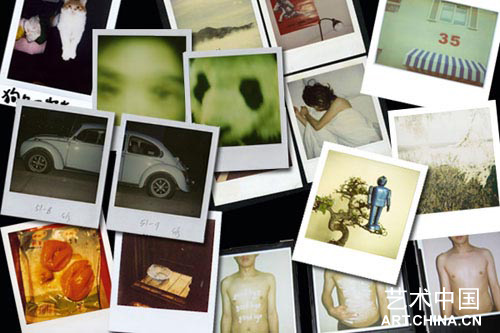
站臺中國——群展《Polaroid》
參展藝術家:杜傑、G.Y、葛磊、黃小璐、孟可、彭楊軍&陳姣姣、仇曉飛&胡曉媛、蘇文祥、兀鵬輝、d-N(楊大為&盧婷婷)
策展人:仇曉飛
開幕日期:2009年7月1日4pm
展覽時間:2009.07.01 - 07.19
站臺中國將於 2009年7月1日 推出由仇曉飛策劃的13位青年藝術家用Polaroid (寶麗來) 作為媒介創作的作品或紀錄的瞬間的群展《Polaroid》。
在數位時代到來之前,隨著底片的流失與相紙的破舊發黃,家庭照片會逐漸成為時間和圖像的“孤本”;與此同時,這些脆弱的相紙也慢慢脫離了它作為圖像附屬品的身份,而作為一件獨立物品的特性逐漸清晰起來。這個由承載圖像的一張紙轉而成為與圖像及退色痕跡融為一體的“物”的過程是隨著時間緩慢演變的。與此不同的是,Polaroid在一開始的時候,即未拍攝之前,就明確了它作為“物”的身份。首先,無需經歷時間與戰爭,它就是“孤本”;其次,從愛德華·蘭德(Edwin Hland)發明這個東西的開始,他的目的就是要“一次成像”。然而這種簡便性卻也帶來了諸多的瑕疵而無法解決,例如無法精確控制的光圈和快門,使照片不是曝光過度就是暗黑沉重,還有機械與色溫問題導致的卡殼和顯影不勻。但這些瑕疵卻反而成為了它獨一無二的美學特性,十分神秘的保持了它與被攝物象的適度距離,從而在圖像附屬品的基礎上加上了一層使其獨立存在的物性特徵。
與這種物體化的魅力所並存的,是Polaroid作為偶然性動機的載體而讓人著迷。從達達主義以來,“偶發性”作為藝術的一種“原始動力”早已被接受並衍生出各種各樣的形式,但Polaroid從動機的發生到看到結果而不能更改僅僅是幾秒甚至不到一秒鐘的時間,如此短暫的過程在很大程度上挑戰了藝術品慣有的深思熟慮和理性特徵。也就是説無論怎樣思考,最終的一瞬都是無法完全預見的。與更多的偶發藝術形式相比,它的表現形式並不激進,但作為在巴掌大的一個小方塊兒上建立的圖像試驗,它的意義卻早已超越了它本身僅僅作為一張照片所蘊含的含義,它微弱地、溫和地給過於理性的、過度由大腦人為操控的世界提供了一個簡便的出口。
我們極其直觀的看到那些物、人、風景是如何通過光而轉移附著在另一物體之上,這種神奇的轉化似乎神助般的在一瞬間內所完成。
Polaroid 2009.07.01 - 07.19
Artists: Du Jie, G.Y, Ge Lei, Huang Xiaolu, Meng Ke, Peng Yangjun & Chen Jiaojiao, Qiu Xiaofei & Hu Xiaoyuan, Su Wenxiang, Wu Penghui, d-N (Yang Dawei & Lu Tingting)
Curators: Qiu Xiaofei
Opening Reception: July 1st, 2009, 4pm
Platform China is pleased to present its next exhibition in 2009 on July 1st - Polaroid,a group exhibition curated by Qiu Xiaofei with 13 young artists will demonstrate their creative works or moment as the medium of using Polaroid.
When the digital era arrives, family photos gradually become the “Only Existing Copy” of time and images with the loss of films and the damagment of photo papers. Meanwhile, these fragile papers slowly stand apart from their identity of image’s accessories, and the characteristics as an independent object clear up. The process that a piece of paper with images printed on it transformed into an “object” together with images and faded traces is slowly evolved over time. What different is, at the beginning of time, before taking a photo, Polaroid’s identity as an “object” was made clear. Firstly, no need to witness time and wars, it’s indeed “Only Existing Copy”; Secondly, when Edwin Hland invented Polaroid, he had a purpose of having an “instant photograph”. However, this simplicity has also brought many problems which could not be resolved. For example, the aperture and shutter cannot be controlled precisely, so that the photo is either over-exposure or too dark, and also the machine and the color warm cause the images to get stuck and develop uneven. But these imperfections had become the unique aesthetic characteristics; mysteriously keep a distance from the photographed object, making the images more independent above its accessories attribute.
What coexists with the object-oriented characteristics is that Polaroid charms people as a carrier of occasional motivation. Since Dadaism, “contingencies” as an original power of art has been accepted and led to a variety of forms. But it need only several seconds even less than one second for Polaroid from having a motive to see the result which can not be changed. Such short process in a large extent challenges the usual thoughtfulness and rational characters of art works. This means that no matter how we think, the ultimate moment is not fully predictable. Compared to other more occasional art forms, it’s not much radical. But as an image test set in a palm-size box, its significance has transcended the concept of the meaning of a photo; it weakly and softly opens out a convenient exit for the world that over rational and over-manipulated by human being’s brain.
We intuitively saw how those objects, persons and landscapes move and attach on another object through light, the miraculous transformation completed in the blink of an eye seems like it got the God’s help.